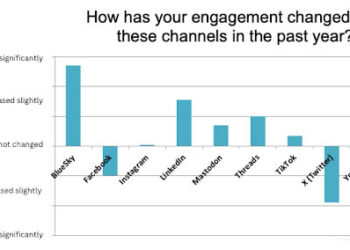 Image via Wikipedia
Image via WikipediaMalcolm Gladwell’s best-seller, “The Tipping Point,” tells stories of how trends get started, often by a small group of highly-influential people he calls connectors.
Interpreting past trends, however, can be a little like Whig history. It is too tempting to look for the people who were involved in the early days of a trend and give them special status as trend setters. Much of marketing focuses on identifying potentially influential people and attempting to have them wear your shoes, listen to your music, or drink your vodka. In reality, it doesn’t take influential people to start trends.
NPR’s On the Media recently featured an interview of journalist Clive Thompson, author of “Is the Tipping Point Toast?” published in the February 2008 issue of Fast Company magazine. Thompson describes that the science behind some of the early studies of networking is somewhat shaky and doesn’t hold up to current research.
For example, in the famous Stanley Milgram small world experiment conducted in the late 1960s, letters were sent to individuals in the Midwest directing them to forward similar letters through friends so that they end being delivered to a stockbroker in Boston. Milgram discovered that the average path length for social networks in the United States was about 6 individuals (to which the phrase six degrees of separation is attributed). Milgram also discovered that most of the letters that got to the stockbroker were sent via only 3 friends. These people are what is what Gladwell calls connectors — individuals with very large social networks. Marketers believe that influencing this small group of people can lead to successful trends.
Duncan Watts, a network scientist at Columbia University currently on leave with Yahoo! recreated this experiment, only with email and not paper mail, and extended it to thousands of individuals around the world. While he was able to replicate the six-degree path length, he could not replicate Milgram’s notion of connectors. Only 5% of the email messages were sent through these kind of individuals.
The notion that only a small number of highly-influential individuals can start trends is being revised by the notion that we are all capable of starting trends. What matters most is whether society is ready for a trend, and less on the persuasive ability of influential individuals.
If society is ready to embrace a trend, almost anyone can start one–and if it isn’t, then almost no one can.
Using a metaphor to illustrate his point, Watts describes that when conditions are right (hot, dry, and windy) almost any lit match, spark, or lightning bolt can start a forest fire. It makes little sense investigating the properties of the first spark.
As a result, the traditional approach of mass advertising may be just as effective as selective (or viral) advertising when the conditions of the market are right.
Discussion
4 Thoughts on "Wildfire or Tipping Point?"
This actually fits in well with the research of Everett Rogers and his work on the diffusion of innovation .
These studies indicate that the ability to incorporate a new innovation into a community is more complex than simply finding the people with the most connections.
And they indicate that the people to work with are the early adopters and the people who connect them to the rest of the social network, the chasm spanners.
This prompted me to wonder how I would go about getting a message to a stockbroker in Boston. The obvious first step would be to look for someone I could mail in Boston itself. Hmmm….Kent Anderson, perhaps?
Good point, Richard!
The classic paper in the diffusion of innovation (predating Rogers) is a study of Midwestern farmers’ adoption of hybrid seed corn in the late 1930s.
Ryan and Gross [1] describe that salesmen were often the source of information about the new seed, but that neighbors were the source of influence (or persuasion) to adopt the new technology.
This is similar to Mark Granovetter’s study [2] of how individuals find jobs — most often through acquaintances (or “weak ties” ) than through close friends (“strong ties”).
There clearly needs to be differentiation between types of connections in a social network.
1. Ryan, B., & Gross, N. C. (1943). The diffusion of hybrid seed corn in two Iowa communities. Rural Sociology, 8(1), 15-24.
2. Granovetter, M. S. (1973). The Strength of Weak Ties. American Journal of Sociology, 78(6), 1360-1380.
Philip,
The Ryan and Gross work is, of course, the research that really provided the first hard data regarding how an innovation diffuses through a community. It is a fascinating example of how really well done fieldwork can provide information that identifies the basic social aspect of innovation adoption.
People do not usually adopt a new thing because it is obviously the best new thing out there. They adopt it because someone they know tells them about it
The S-shaped curve that resulted from their work is particularly useful in understanding how a community changes.
Roger’s work does go further in helping to delineate the process that people use when adopting an innovation.
And Granovetter’s work also helps educate how the community disperses innovation. Strong ties think too much alike. Weak ties with a diverse viewpoint offer new paths for information to travel.
To fully be able to take advantage of a social network, to reduce the rate of diffusion of innovations, much more analysis must be done than simply looking at the connectors.
Finally, do you know where I can get a pdf of the Ryan and Gross paper? All I have been able to find are excerpts.



